#Rich Syracuse
Explore tagged Tumblr posts
Photo

Natural Stone Pavers in New York Ideas for a sizable traditional stone garden path in the front yard that receives full sun during the summer.
0 notes
Text
Chapter I | The word of a Goddess





Summary: The Book of Peace - an ancient book which protects the twelve cities. Stored in the highest tower in the city of Syracuse, the book stands untouched as Prince Sabo brought it home. The prosperity it brings to humanity made it a target to the Goddess of discord Eris, who intends to bring chaos to the people of the twelve cities by making a deal with the famous pirate Portgas D Ace to steal it.
“You're not thinking big enough, Ace. Steal the book for ransom and you can be rich enough to lounge on the beach of a tropical island. Steal it for me, and you can buy the beach. And the island. And the world.” Said Eris, her voice sultry as she passed by Ace, fingers brushing his face.
Main characters: Portgas D Ace x Reader (female) & Eris - Goddess of Discord
Supporting characters: Luffy, Sabo, Marco, Thatch, Izo, Kiku, Whitebeard
Description: This story is entirely based on 'Sinbad: The Legend of the Seven Seas'! Of course I will add my own touch to it and things that are not part of the film, but still it will be following the animation storyline. A lot of lines that I liked from the movie will be included in the dialogue as well.
WARNINGS: explicit language, descriptions of violence, 16+ only, implied injury, illegal activities, physical violence, fighting, mentions of monsters.
Word Count: 6,5K
story masterlist | main masterlist | next chapter ->

NOTE: Here is the first chapter, I'm posting it earlier as I got sick and I couldn't go to work today ♡ Thank you all for supporting me as always ♡ I hope I get to meet your expectations in writing this story in the best way possible especially if you are big fan of the movie as much as I am. I'm definitely having so much fun writing Ace as Simbad so I cannot wait for the story to unfold further especially with the ideas I want to add to it ♡ Enjoy the first chapter and for those of you who are new here - English is not my first language so please if you see any mistakes let me know ♡

Tartarus – The Realm of Chaos. A place covered by ruins of empires and greedy kings; a place almost identical to Hell. Ruled by Eris – the Goddess of Discord, daughter of the primordial night goddess Nyx, she was the pure embodiment of chaos and destruction. She fuels competition and leaves discord in her wake, encouraging both sides of a battle, supporting both sides in an argument and bringing out the worst in people. Nothing good has ever come from her arrival and every time she would appear people will tremble in fear. Eris represents the true malevolence and deviance - she has no morals of good nor nobility, her heart was made of pure evil. She is spiteful, manipulative and passioned about world destruction waiting for the day when the mortal world will crumble in the ruins of her chaos.
Temples and myths portrayed her with wings, highlighting her nature traveling between her realm and the real world. But Eris has no wings, she doesn’t need ones. Her body is not as of a human, even though it appears as one. Tall and slender, eyes bloody red with a yellow background cornea, and a long black hair that flies all over the place with any movement she makes, her shape and form can shift and change. Her forms come from both how she wishes to appear and how her emotions emanate. Eris can control the darkness and merge with it, becoming a shadow herself as her mother Nyx. Yet as a Goddess her face is something every sailor, every king and many gods have fallen for. Her beauty is as destructive as her powers.
The realm of chaos was inhabited by her children – the godly monsters made into constellations. Calling upon them the Goddess entered her realm of constellations looking down upon her globe of Earth.
“Wake up my beauties. Rise and shine.” She called and her children assembled around her. “It’s a new day in the mortal world. Ah, what a beautiful day it’s in there. So peaceful... so boring.” Taking a good look at the Earth, Eris attention got caught by a noble ship in the southern sea. “Just look at them. I pull one tiny thread and their whole world unravels into chaos. Glorious chaos.” Pulling a string out of the globe she chuckled to herself. What a day, not only the ship was led by a noble prince, but he was also carrying a valuable treasure for the humanity on it. Something Eris was looking for some time now – The Book of Peace. “A noble price, a priceless treasure and a black-hearted thief. This couldn’t have been more perfect.” The pirate-ship pursuing the prince’s one didn’t escape her sight. “Oh, this is going to be fun.” Turning around she reached with her hand to one of her children – Cetus, a large Krake-like monster. His body was long eel-ed with eight tentacles, a long tail and a head crown shaped like a fish frill with eyes as yellow as his mother’s. “Cetus?” The monster came closer to his mother once it heard her calling it. “You know what to do.” She purred. “Let the games begin.”
****
Lit by the sun the calm waves of the sea were sparkling, making the endless sight of water on the horizon look mesmerizing. Drifted by the breeze, the massive sleek mahogany color ship was cutting the waves with ease, chasing after the noble royal blue ship in front of it. Pristine and well-maintained, the ship gleamed in the sunlight. The ship had three tall masts with sails in a beautiful burnt orange colour with lighter colour flames embroidered on them. On the deck the small crew of six people was standing in a line listening to their captain’s orders.
“Gentlemen, this is what we have been waiting for.” The captain announced, while taking steady steps towards the bow of the ship, a dog by his side – Spike was following him. “The world’s most valuable object it’s on it’s way to Syracuse – or in other words – our ticket to paradise.” Standing on the bow of the ship and taking a good look at the massive blue royal ship in front of him, he turned to his crew with a big grin on his face. “It’s a shame it’ll never get there.” He said with a confident cocky voice. Laughter from the crew and barks from Spike cheered loudly on the deck. “After today, we retire to Fiji.” His announce made his crew cheer once more as they were ready to fight. Guns shots, swords and matchets were ready to be used as everyone have been waiting for this moment for so long. “Marco.” The captain called for the tall blond man, who was his right hand.
“Aye, Captain.” He responded to his captain, taking a stance next to the helm.
“Spike.” The captain yelled from the bow at his dog giving it a command to pull the lever which activated the ship’s sides blades. Once they were out, Marco manoeuvred the ship getting it as close as possible next to the royal one, and the moment they caught on them he turned the helm in the direction of it and strike it. “Let’s get rich.” Screamed their captain as he grabbed on one of the ropes from the sails and swing with it. He hopped on the royal ship with swift moves declaring his attack on his opponents. His crew and dog followed him immediately. Marco was fast to tear apart a piece of wood from the royal ship and knocked with it at least five men with a single move. Thatch wasted no time and pulled his machetes fast getting into the fight knocking down guards left and right. Even Spike, who was a very smart dog, has knocked two of the guards down, though for him it was like a game not realising the danger he or his owner were in. Speaking of his owner, the black-haired captain, who was surrounded by guards attacking him from all sides, instead of being scared or in distress because of the situation he was in, he was having quite the fun. Kicking and knocking guards left and right, easily taking their swords and handling them with swift moves, it all was like a children’s game to him. With more guards running towards him, he spiked the two swords he had in his hands on the deck’s floor and in one smooth motion, he turned his body clockwise with his hands on the swords and knocked down all the guards.
“Yo, Marco.” He turned to his right-hand man, who was busy on choking a guy between his armpit and forearm. “Did you catch this last move? Pretty cool, hu?” The cocky captain chuckled.
“I thought you overworked it.” Marco responded unimpressed. “Just a pit.” He gestured with his fingers how ‘little’ his captain overworked himself and then landed his fist on the guard knocking him off completely.
“Overworked it?” The captain sighed in disbelief. He didn’t, he was sure he looked pretty cool while fighting the guards. Another guard ran towards them with his sword raised high in the air, only for Marco to caught it with his teeth and threw him off the deck with one move. “Oh, and I was overworking it?” His captain exclaimed as he looked at him over his shoulder. Turning around the captain’s eyes widened, and cocky smile disappeared. On the upper deck he saw no other but the Prince of Syracuse himself. “Sabo.” He said to himself. There on the deck was the prince – a tall, blonde man dressed in his noble blue clothes that represents Syracuse.
“Hm, didn’t expect this? How long has it been since you last saw each other?” Marco asked as he saw the way his captain’s shoulders sagged at the sight of his childhood best friend.
“About a lifetime ago.” Was the only response he got. Walking towards the upper deck, the dark-haired man observed the way the prince was taking down two of his crewmates. “I see you are still fighting like a price.” Chuckled the pirate as he stood behind the prince’s back with his arms crossed and a smug smirk on his face.
“Ace?” A smile appeared on the prince’s lips as he immediately recognised the voice, but the guy he knocked down has jumped back on his feet and pushed the price to the ground. Ace’s crew took a hold of Sabo, but he pushed them away. The prince couldn’t believe his eyes – his long-time lost childhood best friend, who he once considered a brother, was standing right in front of him. Now not as a child or teenager anymore, but as a grown man. With his broad muscular chest on display as only a pair of dark knee-length pants were hanged around his hips and a yellow unbuttoned shirt covered his back with an orange cowboy hat on top of his head, he hasn’t changed that much. His cocky smile was the same, his dark brown eyes were still full of mischief and his face was still covered in freckles. The only difference was that now Ace has gotten taller and much more muscular than before. “What are you doing here?” Sabo was still in disbelief.
“Working.” Ace raised his eyebrows as he mischievously smirked at Sabo and pulled out his dagger from the back of his belt. With one swift move he pierced the door handle with the it and broke it. Taking a look over his shoulder at Sabo, he chuckled. “What about you?”
“What happened to you? Where have you been all this time?” Sabo couldn’t believe how ignorant his friend was being. All these years, ten to be exact, Ace was gone. One day he just disappeared, and Sabo never heard of him again, until today. “Also where is Luffy? I’m sure he came with you.”
“I would love to catch up man, but I have stuffs to do, you know?” Ace turned to look at him once more. “Places to be, things to steal, the usual. And Luffy should be somewhere around here.” He clicked with his tongue and opened the door, not planning on paying any more attention to Sabo. His crew started laughing but Sabo wasn’t having it, instead he followed Ace inside the cabin. Taking a step in Ace whistled once his eyes landed on the treasure in front of him – the Book of Peace. The infamous book, which was known to bring peace among the twelve cities, protecting them from misfortune and chaos. The book was known to be lost but that was only a rumour. If the book was lost or stolen the twelve cities would collapse immediately. It was known that this rumour was created only for pirates and criminals to not go after it – but thanks to Sabo, Ace was aware about this. So now, nothing could stop him from stealing it. He didn’t give a single damn about the people of the twelve cities, so he didn’t care what would happen to them once he has it. Before he can take another step in, Sabo stepped in and placed his hands on Ace’s shoulders stopping him from moving any further into the room.
“Ace, we need to talk.” Sabo’s voice and face were stern as his eyes shifted between Ace and the book.
“Heard about it, read about it, never actually seen it.” Ace jerked away Sabo’s hands and walked into the cabin. Laying open, the book was standing in the middle of the room in all its glory. An ancient priceless treasure. Its blue glow was reflecting on Ace’s face, where his smile was growing bigger with every second. “The Book of Peace.” He breathed out.
“Don’t you even think about it, Ace.” Sabo was quick to warn him as he stood right next to him. “It’s my job to bring it back safety to Syracuse.” He glanced at Ace, with his pierced blue eyes.
“Oh, shit man. Really?” Ace hissed mockingly as he slapped his thigh on the side. “Now, I will feel bad, because you will get fired.” He said as he patted Sabo on the shoulder. Mesmerised by the book Ace started circling around it taking a better look from all its sides. Oh, the amount of money and gold he was going to get for this book. He could see himself and his crew already living in the paradise of Fiji.
“Ace, you can’t be serious.” Sabo’s brows frown as he couldn’t believe what he just heard. Has Ace really turned this heartless? “You disappeared for ten years, on top of it took Luffy away with you, and now you are showing up and you plan to rob me?” He half raised his hands in the air, waiting for an explanation from the man once he called his brother.
“First of all, I didn’t make Luffy come with me, okay? He followed me without me knowing.” Ace pointed his finger to Sabo as he wanted to be clear about why and how ‘their’ little brother ended up disappearing with him. “And I really am sorry, man. I really wish it wasn’t you I was stealing the book from, but...” Ace half shrugged as he stood next to Sabo once again.
“But it’s me Ace.” Sabo’s voice was filled with a lot of mix emotions right now – disbelief, anger, regret but also hope and happiness. The fact that he was seeing Ace after ten years was still unreal to him, also knowing that Luffy was somewhere close by was making his heart filled with excitement. At the end, till this day he was considering these two boys for his blood brothers even thought they weren’t, but the packed they made as kids was something he was panning on honouring till his last day on Earth.
“Sabo...” Ace exhaled before he looked at his long-time friend. “We might of share a glass of sake and fought next to each other as kids, but you see this is the key word – kids. Yea, it was fun, but again – kids.” Ace said as his cockiness and mockery didn’t even drop with one notch.
“We were brothers.” Sabo took a step closer to Ace as he couldn’t listen to his nonsense anymore. “Ace, you are not stealing the book. Not from me.” He shook his head and pointed at the book with the palm of his hand. “And what would you do with the book anyway? This book protects hundreds of thousands of people.”
“Exactly.” Ace exclaimed excitedly. “Now imagine how much you would pay to get it back.” He raised his brows and nudged Sabo on the sides with his elbow. Sabo took a stance in front of Ace and the book and raised his finger warningly at him.
“Let me say this one more time, as it seems you that you don’t get it Ace.” He snapped. “A long time ago – Luffy, you and I were brothers. And if that ever meant anything for you, you would leave now, and I will pretend that this attack on my ship has never happened.”
“Ah, you are right.” Ace shrugged and turned around taking a step away from Sabo. “That was a long time ago.” Taking his sword out, him and Sabo clashed their blades at the same time. With a smooth swift move with his leg Sabo tried to bring Ace down but Ace dodged it by jumping and taking a step back.
“Come on, Sabo. Don’t play all heroic with me. I know deep down you still want to be a pirate.” Ace smirked as he fidgeted the sword easily with his hand. Before Sabo had the time to react Ace attacked him once again. He wasn’t planning on giving up, even if it meant stabbing his childhood friend. Their blades crashed once more as they stood face to face.
“I’ve grown up, Ace. Now if you want the book you will have to go through m-” A loud bang and impact shook the ship as the wooden wall broke and a tentacle broke apart the once so-called brothers. Shaking their heads from the shock of the scene in front of them Ace and Sabo shared a confused look.
“What the hell?” Ace exclaimed and run outside as he heard yelling from his crew and guards. Sabo followed after him and stopped once he saw Ace freezing for a second. The scene in front of them was out of a mythical legend. At the bow of the ship a Kraken-like monster was attacking everyone. Guards were trying to protect the ship, but the monster was ten times stronger than any of them. Taking a quick glance at his ship, Ace smiled as he saw his crew was safe on it. While the guards were fighting the sea monster, Spike unable to understand the danger, ran after one of the monster’s tentacles and bit on it. Ace chuckled at the sight. “Go, Spike.” The monster easily threw the dog in the air sending it flying towards his owner’s ship. Ace laughed as he saw his dog enjoying himself as he landed securely in the arms of the old man in his crew – Whitebeard. For an old guy in his late sixties, he was quite strong and well built.
“Ace.” A loud scream echoed around. Turning his head to where the sound came from Ace’s smile grew bigger. Sabo followed his gaze, and a big grin appeared in his face as well.
“God, he has grown so much.” Sabo couldn’t believe his eyes once again today. There wrapped around the ropes, hopping on them like a monkey on a vine, was the guy he has considered as a little brother – Luffy. Now, that he has grown up even more, his resemblance with Ace was even scarier, considering the fact that the two of them weren’t biological brothers. Yet, till this day Sabo was sure that they shared at least one parent, but they would never know as both were orphans. “You two look alike even more now.” Sabo nudged Ace with his elbow. A makeshift puff of laugher left Ace’s nose as he put his sword back and started to walk away. “Wait, where are you going?” Sabo grabbed his shoulder and turned Ace around.
“I see you are busy, and my crew is waiting. So, uh, we stay in touch.” Ace bumped him on the shoulder and walked towards the railing of the ship ready to jump to his own.
“Sabo is that you?” Luffy screamed as he landed on his feet on the deck of Ace’s ship. “Oh my God, Sabo it’s you.” His eyes sparkled with excitement as he saw the guy who once was his second big brother.
“Luffy, long time no see.” Sabo said. It was like the three once’s brothers forgot that there was a big sea monster destroying the royal ship and swallowing alive half of Sabo’s crew.
“We catch up some other time with him, Luffy.” Ace interrupted them as he was ready to go back to his ship, but Sabo pulled him by the shoulder once more.
“You are just going to run away?”
“Uh, yea.” Ace snorted and just before he takes another step the Kraken-like monster raised his tail from the water, breaking the spikes off Ace’s ship that were holding the ships bridged and almost knocked him in the water.
“Ace.” Luffy screamed as he saw his brother almost falling from the railing. Getting his balance back, Ace frowned his brows now furious at the monster, if it wanted to destroy any ship it should focus on the royal one, not his.
“You fucking bastard. My ship.” He yelled at the monster, as he saw it hitting and breaking the right-side railings on his ship.
Meanwhile Sabo has joined the fight with the Kraken with his men. He wasn’t planning on giving up but when the monster knocked him on the ground for a third time now, for a second he was hopeless. The sea monster opened its mouth and a sharp like a blade tongue almost struck him but one of the guards jumped just in time to protect Sabo and the monster caught the guard instead. Sabo’s eyes widen in both despair and terror as he saw another of his men being swallowed into the monster’s mouth.
“Head’s up.” Turning from where the warning came from, Sabo saw Ace standing next to the cannon as he lit it up and then jumped on it, directing the lit cannon ball in the air. The monster caught it mid air with its tongue and ate it. Standing next to Sabo and helping him to get on his feet, Ace smirked. “Now, stand by for sushi.”
The monster rumbled in pain as the cannon ball exploded in its stomach, which led to it throwing up some kind of stomach juices covering both Ace and Sabo with it. Both whined grossed out by the phlegm that covered them as they tried cleaning the sticky juices from their bodies. Not only this, but it also threw up the last man it swallowed who fell in front of the brothers’ feet. Not wasting even, a second the guard picked up his sword and with a loud scream went to attack the monster again. “This one has balls. You better give him a raise.” Ace said as he followed the ballsy guard with his eyes. To their surprise the cannon ball didn’t do much damage to the monster, in fact it only angered it more. It started trashing the ship even more.
“Come on, Ace. We need to leave the ship.” Sabo yelled and grabbed Ace’s arm ready to run to safe their lives, but Ace stopped him.
“Stay your ground, man.” Ace smirked as he came up with a plan. Placing his thumb and index finger in his mouth he whistled loudly trying to grab the monster’s attention.
“What are you doing?” Sabo knew it was pointless to ask especially if Ace has already set his mind on something. Not paying attention to Sabo, Ace screamed after the monster.
“Hey! Hey, you! Lobster boy, over here!” It was a success. The monster pierced yellow eyes focused on him and Sabo and its sharp like a blade tongue quickly strike. Ace and Sabo jumped back, and it missed them, but the black-haired pirate was quick to take his dagger and pierced the monster’s tonged with it. The monster left a loud roar of pain as it couldn’t move with its tongue pierced to the deck’s floor. “Now, run.” Ace looked at Sabo and grabbed him by the shoulder to run.
“Pull back!” The prince called out for his men as he didn’t want anyone else to get hurt by the raged monster. In that moment one of the broken masts caught Ace’s attention and without wasting any time he grabbed the first rope he saw on the floor and took it in his hands.
“Sabo.” Ace yelled. “Grab hold and let’s go.” He threw one of the ends of the rope around the main mast and Sabo grabbed it immediately. Reaching with his hand to Sabo, Ace gave him a look that said: ‘for the good old times, trust me’ and his once brother grabbed on his hand without any doubt in mind. Both in tack, started climbing the massive mast as Ace stopped for a second and pulled with his teeth a dagger, that was stuck in the middle of it, as he would need more than the one he had for the sake of his plan to work. Once they got on top of the mast and balanced themself Sabo looked at Ace waiting for him to share the plan with him.
“And the plan is?”
“Very simple – try not to get killed.” Ace big cocky grin was placed once again on his face as he cut the rope which was holding the left end of the horizontal mast. Sabo was quick to catch one of the ropes by his side as the mast sharp left edge leaned and pointed at the monster’s head. “Here, you will need this.” Ace said as he handed the dagger to Sabo to catch it.
“Where are you going?” Sabo grunted as Ace jumped to hold himself on one of the ropes that was connected to the bow’s mast.
“Fishing.” Ace replied, which caused Sabo to grunt once more as right now was not the best time for jokes. With one swift move Ace jumped on the rope and balanced himself as he started walking to the other mast. “Left, right, left, right.” He was talking to himself as he was almost twenty meters high in the sky and the last thing he wanted was to fall on top of the monster, serving himself as a meal. Just a second before he jumps on the mast one of the monster’s long tentacles raised in the air and tore the rope, but it didn’t matter as Ace successfully landed on the mast. Balancing himself on it he looked at Sabo, who was carefully following his movement. Ace smiled at him as he pulled another sharp dagger from his belt and cut the right-side ropes which were holding this horizontal mast. Looking down Sabo finally understood Ace’s plan, now with both sharp edges pointing at the monster’s head. Rasing his dagger in the air Ace waited for Sabo to do the same before he screamed at him. “Sabo, now.” Cutting the ropes which were barely holding the masts, the two old friends screamed as they jumped off them and held strong on the ropes as they hung in the air. The sharp edges pierced through the monster’s head, and it fell defeated. Both – Ace and Sabo cheered, and so did everyone around them once they hopped back on the deck’s floor. “You, okay?”
“Yes, I am. Thank you for sticking around, Ace.” Sabo patted his shoulder as his heart filled with joy. He had missed this. All these years he couldn’t stop thinking and missing his two brothers who disappeared one day out of nowhere. But today was his lucky day as finally after ten years he got to see them both.
“Just like old time, man.” Ace would have lied if he said he didn’t enjoy it as well. He did miss his old friend which once he called his brother. As he placed his hand on Sabo’s shoulder his attention caught one of the monster’s tentacles moving in their direction “Look out.” Ace yelled but it was too late. Before Sabo could react for himself, Ace pushed him on the ground. The monster hit the pirate instead, dragging him in the water with itself.
“Ace.” Both Sabo and Luffy screamed as they saw their brother falling into the water. Sabo was ready to jump but the guards were quick to stop him, and so did Ace’s crew stop Luffy as he was an awful swimmer, and he couldn’t survive the vast sea.
*******
Holding him in a strong hold one of the monster’s tentacles was wrapped around Ace’s body dragging him to the deepest of waters. Ace was fighting with all his power, but it was pointless as in the water the monster was even stronger than in the surface. He wasn’t sure how much air was left in his lungs as they were going deeper and deeper until a big shadow-like figure appeared in the water. Ace’s eyes widen as in front of him was standing a stunning goddess like woman. Just before he could pass out from the lack of oxygen, she blowed him a kiss which turned into a big bubble in the middle of the deep-sea water creating an air bubble where Ace could breathe. Gasping for air and on his knees, he was sure he had died and was already in his personal hell. Trying to stand up, the woman’s voice echoed around.
“This day began with such promise and now look.” The voice was sultry and very alluring, a voice for which any man would do any crime just to satisfy its owner. Ace moved his eyes in all directions, but they were so deep in the water barely any light was reaching them, so he could see nothing. Until the goddess like woman showed herself. Her big form appeared like a shadow in front of him. This woman was breathtaking beautiful – with a long black hair, eyes bloody red as her lips and just a long purple dress covering her body. If this was the devil, then Ace was happy for committing all these crimes and that he had died and ended in hell. “My sea monster child is deadly hurt, and I still don’t have the Book of Peace... all because of you Ace.” She shifted her form and now appeared even bigger in front of him, but still beautiful. And she did seem pissed with him. Taking a deep breath Ace finally spoke up.
“And you are?” He extended his hand in a gesture for her to introduce herself, with his cocky tone as aways.
“Eris, the Goddess of Discord.” She shifted her form again as her voice became suaver. “I’m sure you have seen my face on a temple walls.” Shifting her form again she stood in a goddess like form too display all her glory. Ace cursed himself, he was definitely in a trouble.
“You know, they don’t do you justice.” He chuckled at her with a charming smile. After all, there was no woman who had ever not melt into his charm. The Goddess just huffed and rolled her eyes.
“Huh-hu. Now - ” She pushed him on the chest with her giant finger as she was still in her gracious giant form. “About my sea monster.” She was pissed and Ace had to work his charm overtime now.
“Right. I’m sorry about that, Eris. If I knew he was one of yours I would have never.” He tried to be smooth with her, as he was quick to understand that she wasn’t the type to mess up with. “I doubt a heartfelt apology would do.” He played with his fingers as he was tiptoeing around her, careful to not get on her nerves. To his surprise her laughter echoed around them as her eyes pierced him.
“Heartfelt? From you?” She laughed arrogantly once again. “Ace, you don’t have a heart.” Her form shifted again and finally she appeared in a human size in front of Ace. He couldn’t help but lick his bottom lip as he saw her. Yes, he was in trouble. But seeing a Goddess like Eris appearing in front of him was worth the trouble... maybe. She started swaying her hips left to right and placed one hand on her waist as she was slowly and graciously walking towards him. “That’s what I like about you, Ace. Don’t worry, I will let you live.” Once Eris stood in front of him, she placed her hand on his cheek as she caressed it. Ace was in a trance; his eyes widen and mouth slightly gapped. “But there is this little thing you must do for me.” A smug and very luring smile spread across her face. “Steal the Book of Peace and bring it to me.” Placing her hands seducingly on her body she waited for Ace’s respond which didn’t take long.
“Sure, but you see - ” Ace scratched his chin as he gave her a wink. “I have my own plans for the book. Uh, ransom, like... get rich, um some ‘me’ stuff, you know.” He slowly walked away from her but just as he turned Eris was standing in front of him again, which startled Ace.
“You're not thinking big enough, Ace.” Eris started circling around him as she pulled a dragger out of the thin air and waved it in front of Ace’s face. “Steal the book for ransom and you can be rich enough to lounge on the beach of a tropical island.” She pointed the dragger at Ace and then with a smug smile and challenging eyes she pointed it at her. “Steal it for me, and you can buy the beach. And the island. And the world.” Her voice sultry, she passed by Ace now her fingers brushing his face. He crossed his hands and thought about it for a moment. He wasn’t stupid – a deal with the Goddess of Discord meant only one thing – a trap.
“Hm, so you let me live, you make me rich, and I retire to paradise.” He smirked to himself as he thought out loud. “So far so good, no downfalls. If there is no trap and you keep your word.” Now his tone became serious. There must be a trap, it sounded too good to be true.
“Ace, when a goddess gives her word, she is bound for all eternity.” With the dragger in her hand, she made a cross mark with it on her shoulder which didn’t bleed or left any scar it just lit and disappeared. Ace glanced at her and after a moment nodded his head; he would deal with the consequences of his decision later.
“Deal.” He said and Eris came closer to him, brushing his body with hers.
“I knew you would see my way.” Shifting to her goddess like size she made a cut with the dagger in the air opening a portal. “So, when you’ve stolen the Book, you will bring it to me in Tartarus, my realm of chaos. Follow the brightest star beyond the horizon and you will find yourself there.” Ace squinted his eyes a little as the portal and the star itself were too bright, but he made sure to take a good look at them.
“I guess I will see you there Eris.” He chuckled with a smirk once she closed the portal.
“It’s a date then, Ace.” She came closer to him with the dagger in her hand pointing it at his throat, making him gulped. With this move she was making herself clear that he shouldn’t even think of tricking her and that he must kept his word as well. With one swift move she made the dagger disappeared and chuckled. “So, where were we? Oh, yes, you were supposed to hold your breath.” Eris ran her finger across his full lips and pushed him as the air bubble they were in popped. The space around them filled with water and Ace found himself once again in the deepest part of the sea. With the lack of oxygen he quickly made his way to the surface. A sly smile spread across Eris lips. “He is so cute.” She said without moving her eyes from Ace to her sea monster child which appeared behind her in its outline constellation spirit form. “And so gullible.” Everything was going exactly according to her plan. All thanks to Ace. “Cetus, well done.” She finally turned to her child, now her tone sweet and gentle. The monster rumbled a purr as its mother praised him.
*****
Coming on to the surface Ace took a deep gasp once his head was out of the water. Before he had any time to react a hand grabbed him by the collar of his shirt and easily lifted him up. With one swift swing he was on the floor on his ship’s deck. Luffy was quick to jump on him, caging him in a hug.
“Ace, you are alive. I was so worried, and these assholes didn’t let me come after you.” Luffy pulled away as he observed his brother to see if he had hurt himself.
“I’m okay Luffy, I’m not dying anytime soon.” Ace ruffled his brother’s hair as he stood up still unable to breath properly.
“Glad you made it, brother.” Izo, a tall slender man, who had a twin brother Kiku, came behind Ace and patted his shoulder.
“Pay up, he lived.” Kiku called after his twin as they were always betting for anything. It was the same coin going around between one pocket to the other all these years. Ace laughed as he heard what their bet was about this time.
“What happened down there?” Marco took a step closer to Ace.
“Yes, Ace. What happened you were gone for like ten minutes, never do this again.” Luffy scolded his brother as he really thought he had lost Ace. Still trying to fill his lungs with air Ace inhaled and exhaled before he started speaking.
“First – I’m not going anywhere Luffy. And second you wouldn’t believe me even if I tell you.” Ace said out of breath as talking seemed to be like an impossible task right now.
“Try me.” Marco crossed his arms across his chest waiting for Ace to explain. Shifting his eyes between Luffy and Marco he sighed and rolled them.
“So, I met the Goddess of Chaos - Eris down there, and she has a major crush on me, by the way and we made a deal that our first date is at her place after I steal the Book of Peace and bring it to her.” He said in one breath. Marco and Luffy looked at each other and burst out laughing and so did the rest of the crew as they heard the story.
“Ha, that was a good one. I guess we need to stop your access to oxygen more often.” Said Marco as he turned around to walk to the upper deck where the rudder was.
“Oh, I’m writing that down. Goddess of Chaos, haha, my ass.” Thatch laughed loudly as he followed Marco.
“So, no Book, no retirement. What do we do now, Ace?” Luffy, who he had already climbed on some ropes, asked as he hanged next to Ace.
“A little patience, Luffy.” Ace chuckled at his little brother. Always in a hurry this kid, now a grown man but still a kid in Ace’s eyes, he never mastered the power of patience. “Plus, we know where it’s going.” Ace pointed with his eyes towards Sabo’s royal ship which had taken quite lot of damage, but they were still going to make it to Syracuse without a problem. Luffy followed Ace’s gaze and smiled as he locked his eyes with Sabo who was looking at them both. Making sure that his brothers would hear him, Sabo shouted as loud as possible.
“Men, all sails to Syracuse.”

END NOTE: Describing a battle, fighting moves, a monster and a Goddess is so, so hard Imao. I really hope I manage to describe it in a way you guys could imagine it easily. But it was also fun, I really hope you enjoyed it. Reader is appearing in the next chapter so have patients (don't be like Luffy hihih). Thank you for reading my stories and ideas ♡ From the next chapter there will be more things that I have come up with to add, but still don't forget I'm following the movie storyline and that story is entirely based on it! Please comment you opinion as it's always very important to me ♡ Feel free to like and reblog as this way the story will reach more people ♡

writing, format & dividers © eand47 ©eand47, do not copy or plagiarise my work.
#portgas d ace#one piece#fire fist ace#portgas d ace x reader#one piece ace#portgas ace x you#portgas ace x reader#one piece x reader#one piece x y/n#ace x you#asl brothers#asl trio#asl one piece#portgas ace x y/n#ace x y/n#ace x reader#one piece x you#one piece sabo#revolutionary sabo#one piece luffy#straw hat luffy#monkey d. luffy#marco the phoenix#whitebeard pirates#whitebeard one piece#whitebeard crew#op x y/n#op x you#op x reader#ace one piece
73 notes
·
View notes
Photo
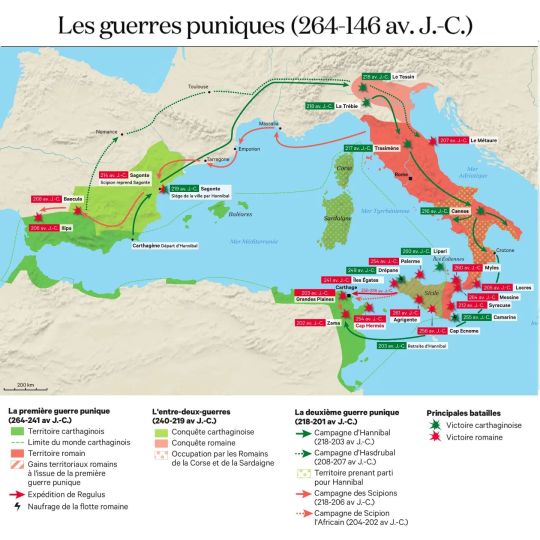
The Punic Wars, 264-146 BC
« Atlas historique mondial », Les Arènes, 2019
by cartesdhistoire
Rome and Carthage stood as the dominant powers in the western Mediterranean. Between these two influential states lay the island of Sicily. Situated at the crossroads of Europe and Africa, and bridging the eastern and western Mediterranean basins, Sicily held immense strategic importance. Rich in wheat and boasting a heritage of prosperity bestowed by both the Carthaginians in the west (in Palermo) and the Greeks in the east (in Syracuse), the island flourished. The Carthaginians established their capital at Lilybaea (modern-day Marsala) and maintained a major naval base at Drepane (modern-day Trapani).
In 264 BC, the onset of the First Punic War marked the first engagement of Roman legionnaires outside of Italy. While battles were fought in open fields, guerrilla warfare, and sieges, the defining feature of this conflict lay at sea. The pivotal Battle of the Aegate Islands in 241 BC resulted in the defeat of the Carthaginians, triggering another conflict, the far more perilous Mercenary War, on African soil. Fueled by grievances over unpaid wages, mercenaries and local allies revolted against Carthage, plunging the region into turmoil until order was restored by Hamilcar in 238 BC. A peace treaty with Rome was signed on March 10th.
The Second Punic War, commencing in 218 BC, was marked by an intriguing characteristic: personalization. The conflict became synonymous with the personalities of Scipio, later known as "the first African," and Hannibal, one of history's greatest military commanders. Hannibal's audacious invasion of Italy, driven by a desire to avenge Carthage's honor, catalyzed the war's escalation.
The war culminated in the Battle of Zama in 202 BC, leading to the signing of a final treaty in 201 BC. From this point forward, Rome emerged unchallenged in the Mediterranean. However, it wasn't until 197 BC that the Senate formally established the two provinces of Spain.
77 notes
·
View notes
Text

Rich Street, Syracuse, New York.
66 notes
·
View notes
Text
An alternate take on "Sinbad: Legend of the Seven Seas" (2003)

I'm back with another Dreamworks rewrite! To be honest, I LOATHE this movie because a lot of it feels like wasted potential, and I wanted to fix some things. Be warned: as you may have guessed, this is all subjective changes. Be sure to check out my rewrite of "El Dorado" as well!

Character overhaul for Sinbad. Similar to Flynn Rider, he's supposed to come off as charming and clever, but instead just comes off--to me, at least--as sleazy and goofy. Sinbad has good moments, but he's willing to let his own best friend die because he believes Proteus' father won't let him die. He's right about Dymas, but Sinbad underestimates Proteus' integrity, showing how little he knows his friend. In fact, he doesn't really change gears until Eris attempts to deceive him; the whole journey, he comes off as arrogant and pompous, not at all likeable except when he saves Proteus on impulse at the beginning. In my rewrite, he's much more smooth and intelligent, calm and logical, in contrast to Proteus' more emotional and compassionate personality. He's much more honorable--YES, he's still a pirate--and is much less bold, ie showing up to Syracuse in disguise in order not to rouse suspicion or get Proteus in trouble. He may or may not still be seducing and stealing while he's there, though. And even though it won't impact the plot much, I'd make him Middle Eastern as a nod to the original cycle of stories (IDK if it was confirmed if he was Greek or not).

2. Fleshing out the crew more. While Sinbad's crew is made up of unique characters, they don't feel like people to me. They mainly seem to exist for comedy and due to the fact that Sinbad can't man the ship alone. This critique is rather vague since I don't have specific things that I'd change, but having more conversations with them between themselves, as well as with others (such as Marina, Sinbad, and Proteus) would've made them feel like actual characters to me. Kale and Rat in particular feel like they could be even more interesting.

3. Marina is...different. Let me make something clear: I'm TIRED of battle of the sexes dynamics in movies that don't revolve around gender. And I hate how the writers decided to hurt Proteus by making Marina his fiance and then have her fall in love with Sinbad. Instead, Marina is a noble, but not the firstborn, and thus has a bit more flexibility under her belt for her life decisions--though when she decides to join Sinbad, it's still met with an uproar from the bureaucracy. Sinbad recognizes her intelligence and combat skills, as well as her desire to explore, so he accepts her as a crewmember, since he thinks he needs all the help he can get. Some crewmembers due try to charm and flirt with her, but as time goes on, this becomes more platonic rather than serious; I know the optics of a shipfull of thirsty men and one woman can be...uncomfortable, to say the least.

4. Proteus breaks. I'd like to think that Dymas succeeds in getting Proteus away from Syracuse--albeit against Proteus' will--and instead takes his place, knowing someone will have to answer for this. This would happen around the middle of the film, and Eris sees this as an interesting turn of events. She uses her powers to kidnap Proteus and bring him to Tartarus, allowing him to see everything that is occurring and has occurred during the journey--albeit with a bit of twists. Eris makes it look like Sinbad DID steal the book of peace, and that even though he ventures to Tartarus, it's all a ruse, as he has the book in his possession in exchange for riches that only a goddess can give. Proteus has a hard time believing this (especially when it comes from a goddess of chaos), but slowly he does begin to wonder if he had too much faith in Sinbad, and if their friendship was based on him desperate to escape the confines of his station. As such, Proteus makes his own deal with Eris to test Sinbad's character. Eris attempts to trick Sinbad by asking him which is mroe important: restoring peace or getting his friend back. Despite his friendship with Proteus, he recognizes how Eris stealing the book will create destruction must greater than he can comprehend. That said, he lies and says that Proteus is more important, but Eris sees through his lies and sends him away--albeit with Proteus, who bitterly wonders why Sinbad bothered to lie. They fight, but when Sinbad can't bring himself to harm his friend, they reconcile so that Sinbad can face the consequences of the stolen book and Proteus face his punishment for escaping.

5. MORE. FLASHBACKS. We had a lot of "tell, don't show" in the original films, and it made the events weigh less than if we had seen them ourselves.

6. The duality of Eris. In Hesiod's "Works and Days," Eris is the name of two deities, one who is beloved once you come to understand her, and another who is feared and despised--but still given her dues since she's a goddess. In the film, Eris is the antagonist, but is more troublesome than completely evil; she wreaks havoc and thrives in discord, but is unable to break a vow that she makes (as far as we know). It'd be fun if throughout the story, we see Eris doing things on a whim, both helping and hurting others rather than just enjoying destruction. However, this duality makes her VERY untrustworthy to mortals, since in my version, the two goddesses are one, so you never knew who you'll be dealing with. Her duality would essentially serve as a metaphor for trustworthiness and change; is Sinbad the thief completely selfish? Is Proteus the gentle prince incapable of corruption? And I'd make the Book of Peace a highly coveted commodity; Syracuse is a paradise since the book offers them riches and prosperity (still distributed unevenly among the masses, mind you), so once it's gone, the kingdom is thrown into disruption, and the threat of invasion and collapse is very real.

7. The journey is different. I do like the idea that Eris is a bit more present rather than being an observer, and throughout the journey, she tests Sinbad's mettle and attitude, wondering if he's willing to sacrifice his morals or his crew in order to get the book of peace. The sirens sing of knowledge beyond the mortal realm, but Sinbad is unwilling to risk his crew going mad for that knowledge. The following trials also test his intelligence and integrity, as well as furthering his bond with Marina.
These are just some ideas, but I do think I'd enjoy "Sinbad" if it had incorporated some of these concepts. Lemme know what you think of this alternate take!
58 notes
·
View notes
Text
David in rep: 2000's The Rivals, The Comedy Of Errors and Romeo and Juliet
In the recent Putting It Together podcast - which was utterly brilliant and something you should go listen to RIGHT HERE IMMEDIATELY if you haven't already! - David mentions his rep seasons with the Royal Shakespeare Company, where he did three plays in rep. His first rep season was in 1996 (when he did The General From America, As You Like It, and The Herbal Bed). His second rep season came around in 2000-2001, when he did simultaneous runs in Romeo and Juliet, The Comedy Of Errors, and The Rivals. I recently found an amazing July 2000 article about this series of plays, and I'd like to share some of its precious informative nuggets as well as talk a bit about each production.
As mentioned, the three productions ran in rep. For you non-theatre types, that means each production would rotate nights. For example, if The Rivals was on a Monday, The Comedy of Errors might go on Tuesday, then Romeo and Juliet on Wednesday…and then the schedule would rotate back to the beginning. Get the picture? Good.



Let's begin in January 2000.
That January, David arrived in Stratford and took a flat near Anne Hathaway's cottage so he could begin rehearsals for two of the three productions: The Rivals (and his role as Jack Absolute) and The Comedy Of Errors (as Antipholus of Syracuse). He added a third role to his schedule in late April or early May 2000 when rehearsals began for his role as Romeo in Romeo and Juliet.
As you can imagine with this kind of schedule, David was soon running himself ragged. Rehearsal followed by show, followed by rehearsal…again and again and again. He had to leave some rehearsals early to do warm-ups for one of the other shows before going on. As he said in the podcast I mentioned above, this brutal schedule left him "battered." However, once all the plays went into production and left rehearsals behind, he only (only?) had to do eight shows a week and would get days off here and there. He called it "quite full on," but said it was either that or not get the parts at all.
The first of these three productions - The Rivals - began its run at Stratford's Swan Theatre from late March til early October 2000. It then ran at the Newcastle Playhouse from late October 2000 to early November 2000. Then it went to London's Barbican Theatre from mid December 2000 until April 2001.


The Rivals programmes from my personal collection - the one on the left is from the Stratford run, and on the right from the Newcastle run
The Rivals centers around the complicated relationship between Lydia Languish and strategizing young lover Captain Jack Absolute. David played the role of Jack, who pretends to be a soldier named Ensign Beverly to win Lydia's affections. He knows Lydia, a wealthy young woman who wants to marry for love, not money, would have no interest in him if she thought he were rich (more about the play can be found here).
Fans have seen some of the photos from this production: this famous photo of David in a door frame by Simon Annand is but one. The comment Mr. Annand made about his memories of that shot is also interesting, I think, and I include it here.


Other photos of this production were taken by Chris Parker, among others.
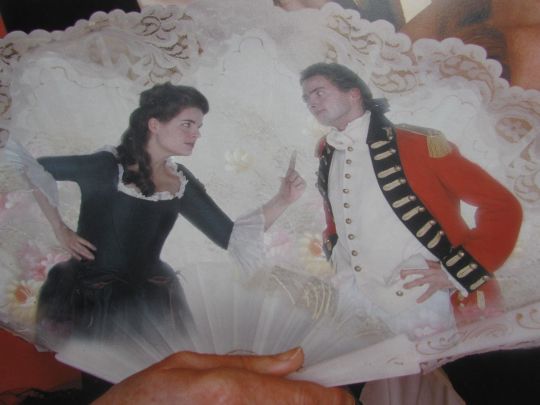


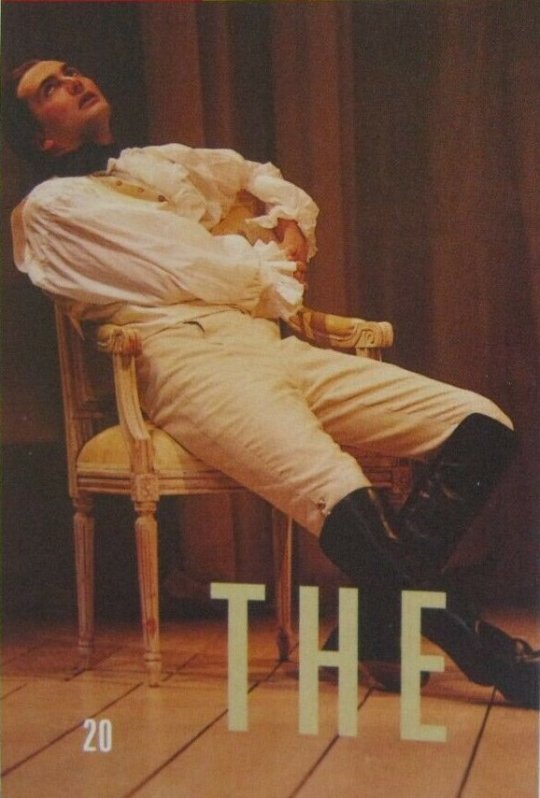
But here's where it gets good. From the article I mentioned, we are treated to these brand new photos! In the first, he's in his dressing room getting ready for his performance as Jack Absolute. In the second he's in the makeup chair getting his hair and makeup checked, and in the third, at his dressing room table taking his makeup off after a show.

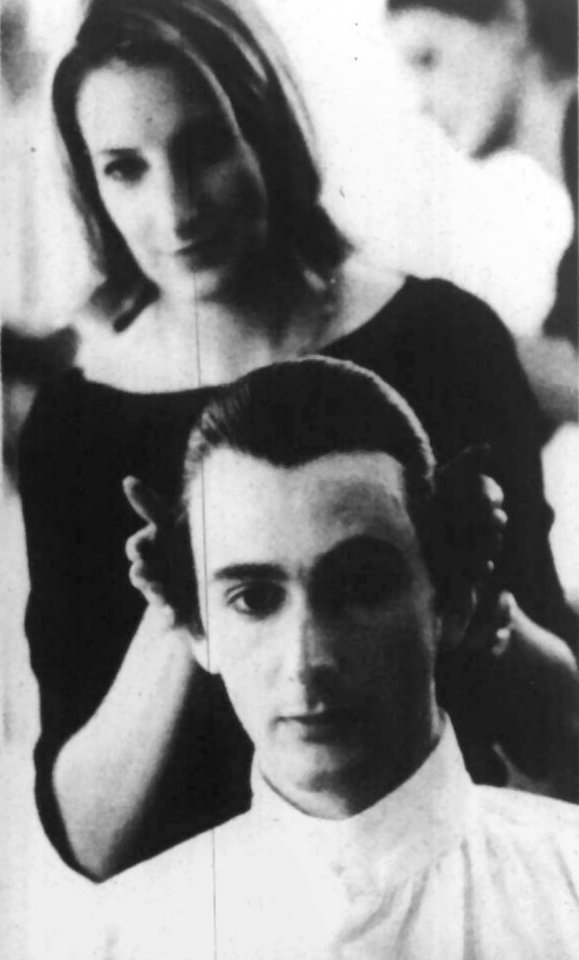

The second of the three productions - The Comedy Of Errors - began its run at Stratford's Royal Shakespeare Theatre from mid April to early October 2000. It ran at Newcastle's Theatre Royal in mid November 2000, then went to London's Barbican Theatre from late Nov 2000 until early Feb 2001.

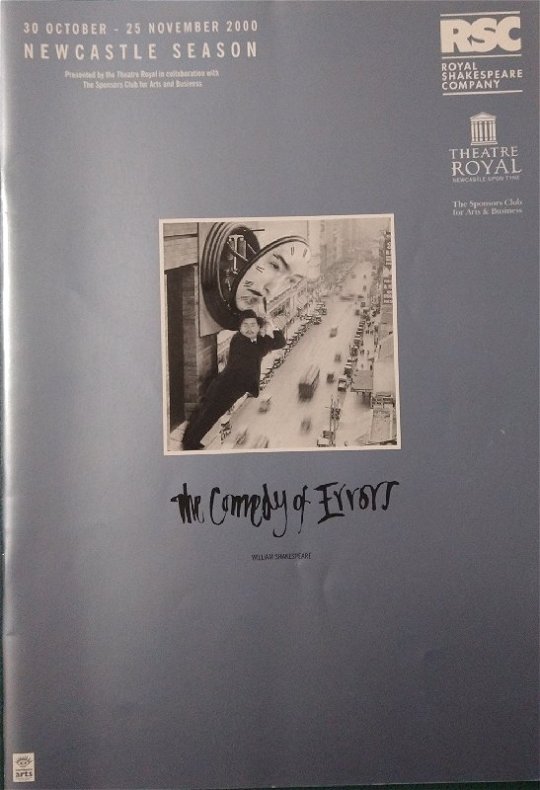
The Comedy Of Errors programmes from my personal collection - the one on the left is from the Stratford run, and on the right from the Newcastle run
David played Antipholus of Syracuse, who was raised by his father Egeon in Syracuse and is one of a set of long-separated identical twins. His mother, Aemilia, and brother, Antipholus, live in Ephesus. A of S is the only figure to whom Shakespeare grants an interior life, and his quest to find his mother and sibling comes with a series of wild mishaps based on mistaken identities (more about the play can be found here.)
But again from the article I mentioned, here are a few brand new photos of David relating to this production! In one, he's relaxing in the Green Room. In another, he's waiting to go onstage as Antipholus, and in the third, he's hanging backstage with fellow actors Des Barritt and David Troughton from Henry IV, Part 1!



The third of the three productions - Romeo and Juliet - began its run at Stratford's Royal Shakespeare Theatre from late June to early October 2000. It ran at Newcastle's Theatre Royal in mid November 2000, then transferred to London's Barbican Theatre from mid January 2001 until early March 2001.


The Romeo and Juliet Stratford run programme is from my personal collection; the Newcastle run poster is from the RSC
David played the lead role of Romeo - a role I hope I need not explain to anyone in depth? David himself wrote a lot about his experiences in the role, and if you're curious you can pop over right here to read the essay he wrote. And if you want to see a ton of photos from the production itself, the lovely mizgnomer did this extensive thread of them some time ago that you should definitely check out!
One of the things he had to do as Romeo was duel Tybalt and Paris, which meant David had to practice fight scenes in rehearsals (something he wasn't completely unfamiliar with, by the way, as he did fencing in drama school - and he was quite good at it, too). Anyway - cue this fabulous photo of David during rehearsals!

And the article also proves David can be cheeky indeed!
In rehearsals for Romeo and Juliet, the article says, it reveals it was David who suggested inserting a scene full of filthy puns into Act II, Scene I, where the hung-over Montague lads go in search of Romeo. And during another part of the rehearsal, David asks director Michael Boyd, "When I enter for this scene, do I come out of the fallopian tube?" - no doubt referring to this part of the set!

Well that's it - and oh yes, I must give credit where credit is due! All the new photos are by Robert Workman from a 2000 Scotland On Sunday article entitled, "Enter Mr. Tennant, centre stage", and all are copyrighted by National World Publishing, Ltd.
And I'd be remiss if I didn't leave you with a teeny glimpse of DT as Romeo!
54 notes
·
View notes
Text
SAINT OF THE DAY (December 13)

St. Lucy is a virgin and martyr of Syracuse in Sicily, whose feast is celebrated on December 13th.
According to tradition, Saint Lucy was born to rich and noble parents in the year 283.
Her father was of Roman origin, but his early death left her dependent upon her mother, whose name Eutychia seems to indicate that she was of Greek heritage.
Like so many of the early martyrs, Lucy had consecrated her virginity to God, and she hoped to devote all her worldly goods to the service of the poor.
Her mother Eutychia arranged a marriage for her, but for three years, she managed to postpone the marriage.
Lucy prayed at the tomb of Saint Agatha to change her mother’s mind about her faith.
As a result, her mother's long haemorrhagic illness was cured, and she consented to Lucy's desire to live for God.
Lucy’s rejected bridegroom, Paschasius, denounced Lucy as a Christian.
The governor planned to force her into prostitution, but when guards went to fetch her, they could not move her even when they hitched her to a team of oxen.
The governor ordered her to be killed instead.
After a gruesome torture, which included having her eyes torn out, she was surrounded by bundles of wood that were set afire, but the fire quickly died out.
She prophesied against her persecutors and was then executed by being stabbed to death with a dagger.
According to later accounts, Lucy warned Paschasius he would be punished.
When the governor heard this, he ordered the guards to gouge out her eyes.
However, in another telling, it was Lucy who removed her eyes in an attempt to discourage a persistent suitor who greatly admired them.
When her body was being prepared for burial, they discovered her eyes had been restored.
This and the meaning of her name ("light" or "lucid") led to her patronage with eyes: the blind, eye trouble, and other eye ailments.
10 notes
·
View notes
Note
Hello Dr. Reames! Why do you think Alexander never set his sights on the conquest of Sicily - a rich island with longstanding Greek presence? Is it because when he came to the throne the plan to invade Persia was already on its way? I understand that Rome was a backwater town at this point and that Persia was the bigger prize, but Sicily always remained rich and hotly disputed
Inertia had a lot to do with Alexander’s choice, plus SIZE of the conquest, plus a plausible reason for the attack. I’m going to address these backwards.
Sicily, at least in the east, was—as you note—Greek, it’s largest city, Syracuse, Corinth’s most famous (and successful) colony. If conquest was still a valid reason for war in his world, increasingly parameters were put on it. We may understand these as window dressing concealing motives often economic (“follow the money,” ancient version). Yet by the 4th century, attacks on “fellow Greek” city-states needed some sort of rationale beyond naked ambition—often a current or historical beef.
Hence, Philip’s reason for attacking Persia (all about the money) was vengeance for the Greco-Persian Wars of over a century prior.
Another example, with Sicily in particular: Athens attacked Syracuse during the Peloponnesian War because she wanted Sicilian timber (for naval construction), after Brasidas of Sparta had convinced Perdikkas II of Macedon to cut off Macedonian timber—which had been Athens’ supply since the Greco-Persian Wars. Yet Athens justified the attack because Syracuse was a daughter-city of Corinth and Corinth was a member of the Peloponnesian league. Not to mention the war began due to Athenian-Corinthian aggression. So, by extension, Syracuse was tagged as an enemy of the Delian League (e.g., Athens’ not-so-covert empire), and ripe for hostilities.
Alexander didn’t have a ready-made excuse to attack Sicily. He probably could have found one, if he’d really wanted to, but this brings me to my second point.
Sicily is just not that big. And if some of her cities were wealthy enough, they didn’t begin to compare to Persia. When it comes to Alexander, “Think small” was never his modus operandi. LOL. Sicily would have been regarded like the Greek city-states of Anatolia (Asia Minor): a worthy acquisition…on the way to Bigger and Better. Yet Sicily lay west…not on the way to Bigger and Better. Just then. (more below)
Last, and the real reason: simple inertia.
Persia was the campaign his father had planned for probably a decade, and had fought south Greece to line up support for, culminating in the Battle of Chaironeia and the League of Corinth. Alexander did have to spend his first two years re-pacifying the Thracian and Illyrian north, not to mention re-fight Thebes to keep the south quiet … but PERSIA was what he’d been hearing about for years—what all Philip’s alliances were formed to pounce on.
To suddenly change and set his sights west on Sicily wouldn’t have made much sense, not to mention it would have alienated some of the city-states he needed (particularly his naval allies). He couldn’t have sold it as a “Panhellenic” crusade in revenge for the Greco-Persian War.
So, basically, I doubt it would ever have occurred to Alexander to sail west to attack Sicily when Persia was the bigger—and long planned upon—prize.
Now, let me add that—if academic speculation is correct and Alexander was setting up a campaign against Carthage near the end of his life—it’s quite likely that Sicily, and especially Syracuse, would have figured into that…but as allies, just as later with Rome. Carthage had long held the western part of Sicily, and struggled with the Greeks in the east for control of the whole. Conflicts with Carthage are why Syracuse invited in Rome for what became the First Punic War.
By the end of his life, and after Agis’s Revolt was crushed, Alexander was such a power, the Greek city-states had mostly given up opposing him. They contented themselves with snarky remarks and symbolic gestures—until after ATG’s death, when they rose up to try and oppose Antipatros in the Lamian War…which failed.
Yet if we could suppose Alexander had recovered from his last illness and did attack Carthage, Syracuse (et al.) would have been all over that. They’d have stood to benefit handsomely in territorial acquisitions. And at that point in time, Alexander probably was the only power that could have beaten Carthage on the water.
Hope this helps to explain why Alexander’s focus was always Persia.
A last thing: the nature of the Greek landscape, with the formidable Pindus Mountains down the center, had divided the peninsula east and west for centuries. The city-states on the east fronted the Aegean Sea, while those on the west fronted the Corinthian and Adriatic Seas. This affected both colonization and conquest ambitions. So eastern city-states tended to look east and western (including the Peloponnesos) tended to look west.
Macedon looked east. By contrast, Epiros looked west. That’s why Alexander of Epiros went to Italy while his nephew went to Persia. Never underestimate the impact of simple geography on history in the ancient world.
#asks#ancient Sicily#Syracuse#Alexander the Great#ancient Macedonia#ancient Greece#Alexander the Great's campaigns#Philip of Macedon#ancient Persia#Peloponnesian War#Greco-Persian War#Alexander the Great's ambitions#Classics
17 notes
·
View notes
Note
What does the expression "mushroom rival" mean in the context of incipient sister-in-law Janet?
The passage:
Even in her slumber she had instinctively felt that a Lennox was worth rousing herself for; and she had a multitude of questions to ask about dear Janet, the future, unseen sister-in-law, for whom she professed so much affection, that if Margaret had not been very proud she might have almost felt jealous of the mushroom rival.
Mushroom?
It seems to be something along the lines of an upstart rival. There's someone on Quora suggesting that there are class connotations, with the nouveau riche being called "mushrooms". It's also used here in a history of Syracuse, New York from 1896:
The development of this rivalry was due chiefly to a class of the inhabitants of Salina who found it impossible to remain silent and inactive while being outstripped by a mushroom rival that was a mere hamlet in a swamp when their own village was a large and prosperous place.
There I think it's clearly that the new rival has come up suddenly, like a mushroom, where Salina has been established for much longer.
I think the situation between Janet and Margaret is similar. Janet has a sudden new claim on Edith's affections, but Edith has known Margaret far longer.
10 notes
·
View notes
Text
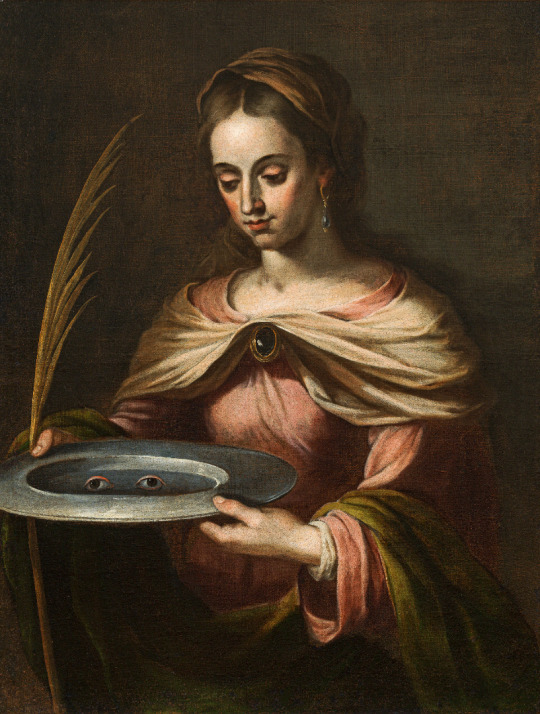
THE DESCRIPTION OF SAINT LUCY OF SYRACUSE The Patron of the Blind and Throat Infections Feast Day: December 13
"Those whose hearts are pure are temples of the Holy Spirit."
Lucy, or Lucy of Syracuse was born of a noble family in Syracuse in the year 283 AD, and believe it or not, she is one of the best known virgin martyrs, along with Agatha of Sicily, Agnes of Rome, Cecilia of Rome and Catherine of Alexandria. Her father was of Roman origin, but died when Lucy was five years old, leaving her and her mother without a protective guardian. Her mother's name, Eutychia seems to indicate that she came from a Greek background. Lucy's name can branch from two words: 'lux' (Latin) meaning 'light,' and 'lucid' (English) which means 'clear,' 'vivid' and 'intelligible.'
At an early age, she secretly consecrated her virginity to the Lord, and she hoped to distribute her dowry to the poor. However, Eutychia, not knowing of Lucy's promise, and suffering from a bleeding disorder, feared for Lucy's future. Agatha had been martyred 52 years before during the Decian persecution. Her shrine at Catania, less than 50 miles from Syracuse, attracted a number of pilgrims; many miracles were reported to have happened through her intercession. Eutychia was persuaded to make a pilgrimage to Catania, in hopes of a cure. While there, Agatha came to Lucy in a dream and told her that because of her faith her mother would be cured and that Lucy would be the glory of Syracuse, as she was of Catania. With her mother cured, Lucy took the opportunity to persuade her mother to allow her to distribute a great part of her riches among the poor.
Eutychia suggested that the sums would make a good bequest, but Lucy countered these words: '…whatever you give away at death for the Lord's sake you give because you cannot take it with you. Give now to the true Savior, while you are healthy, whatever you intended to give away at your death.'
News that the patrimony and jewels were being distributed came to Lucy's betrothed, who denounced her to Paschasius, the Governor of Syracuse. Paschasius ordered her to burn a sacrifice to the emperor's image. When she refused, Paschasius sentenced her to be defiled in a brothel.
It was the year 304 AD, during the Diocletianic Persecution. Christian tradition states that when the guards came to take her away, they could not move her even when they hitched her to a team of oxen. Bundles of wood were then heaped about her and set on fire, but would not burn. And finally, Lucy met her death by the sword thrust into her throat.
According to later accounts, before she died she foretold the punishment of Paschasius and the speedy end of the persecution, adding that Diocletian would reign no more, and Maximian would meet his end. This so angered Paschasius that he ordered the guards to remove her eyes. Another version has Lucy taking her own eyes out in order to discourage a persistent suitor who admired them. When her body was prepared for burial in the family mausoleum it was discovered that her eyes had been miraculously restored. This is the reason that Lucy of Syracuse is the patron saint of those with eye-related diseases.
Her major shrine can be found in San Geremia in Venice. Her traditional feast day, known in Europe as Saint Lucy's Day, is observed by Western Christians, and she was honored in the Middle Ages and remained a well-known saint in early modern England.
This is particularly seen in Scandinavian countries, with their long dark winters. There, a young girl dressed in a white dress and a red sash (as the symbol of martyrdom) carries palms and wears a crown or wreath of candles on her head. In Denmark, Norway, Sweden, and parts of Finland, girls dressed as Lucy carry St. Lucia buns in procession as songs are sung. It is said that to vividly celebrate St. Lucy's Day will help one live the long winter days with enough light.
Villagers from Barangay Sta. Lucia in Magarao, Camarines Sur in the Philippines, hold a novena to St. Lucy nine days before her feast. A procession of the saint's image is held every morning at the poblacion or village centre during the nine days leading up to St. Lucy's Day, attracting devotees from other parts of the Bicol Region. Hymns to the saint, known as the Gozos, as well as the Spanish version of the Ave Maria are chanted during the dawn procession, which is followed by a Mass.
#random stuff#catholic#catholic saints#saint lucy#santa lucia#lucy of syracuse#lucia de siracusa#eye infections#blind#throat infections
26 notes
·
View notes
Text


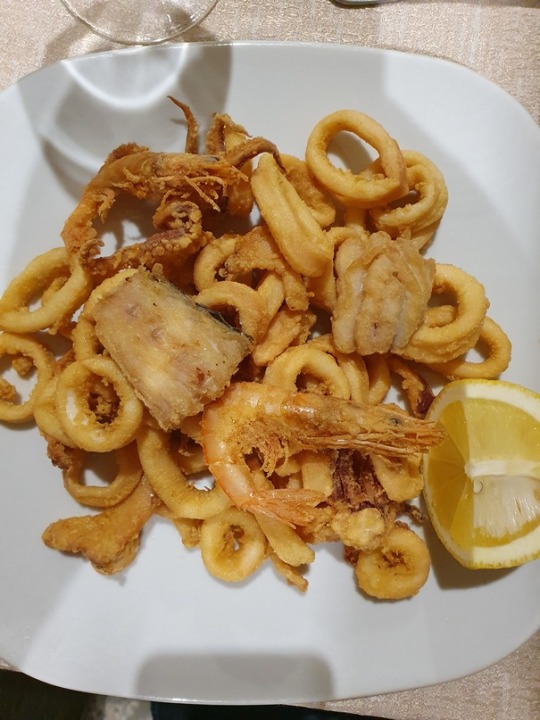


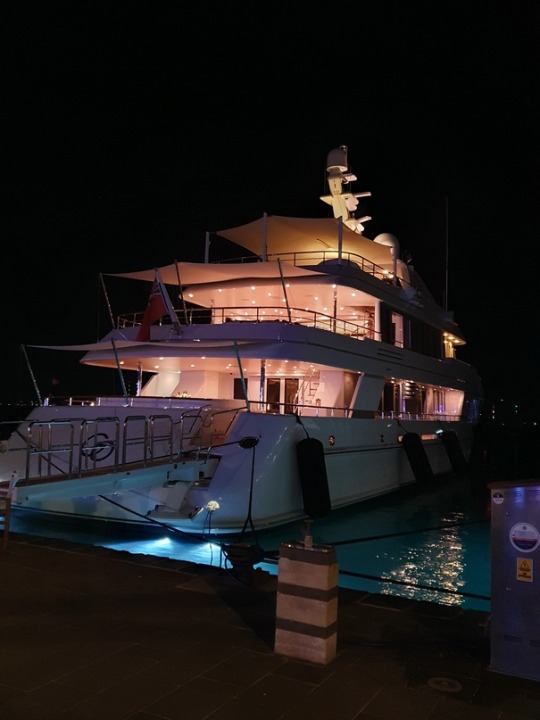
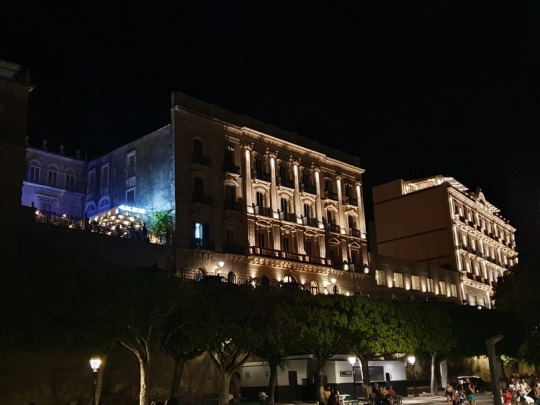
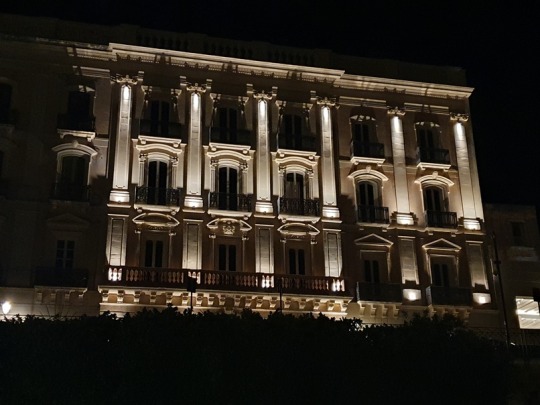

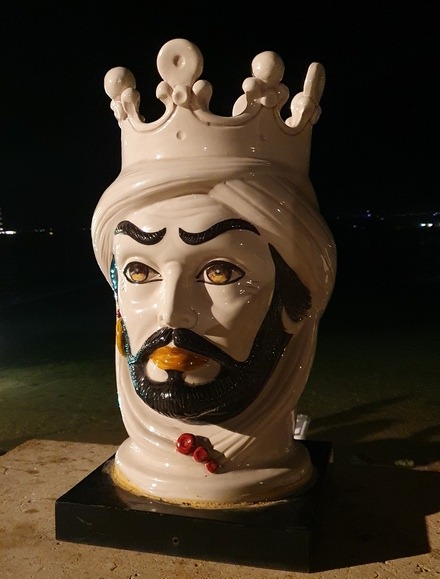
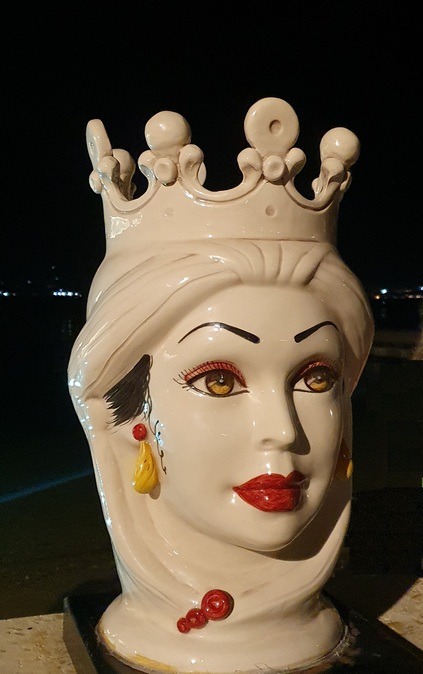
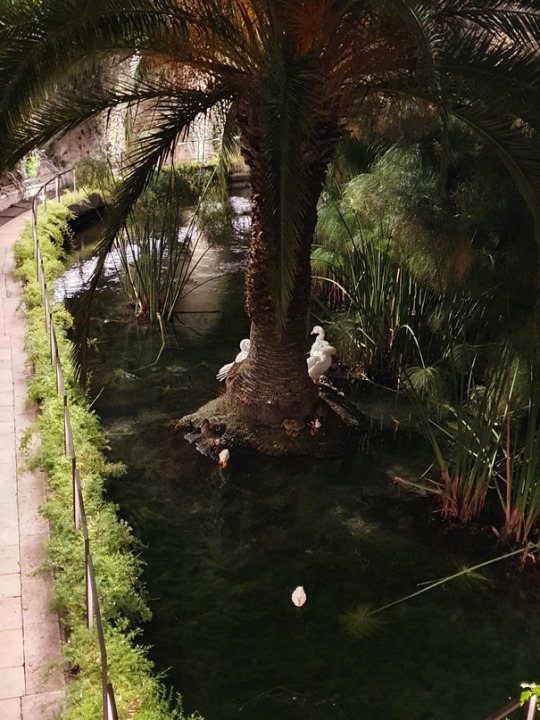
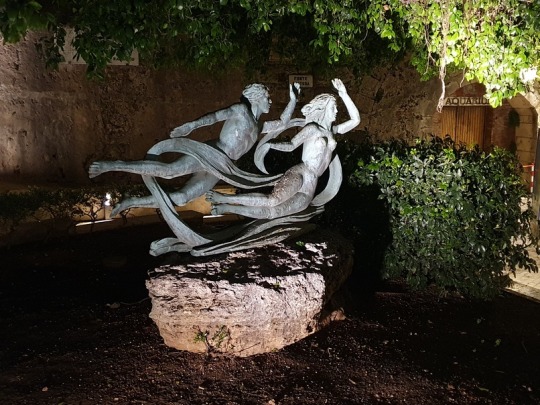


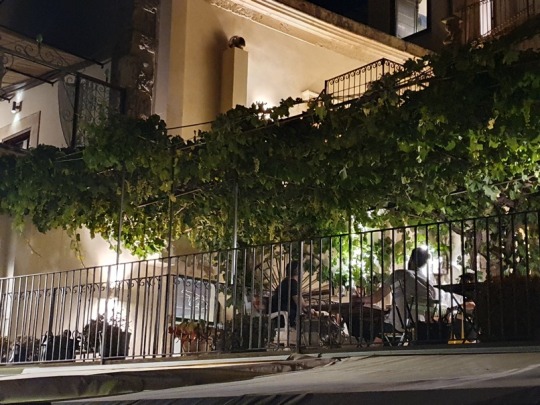
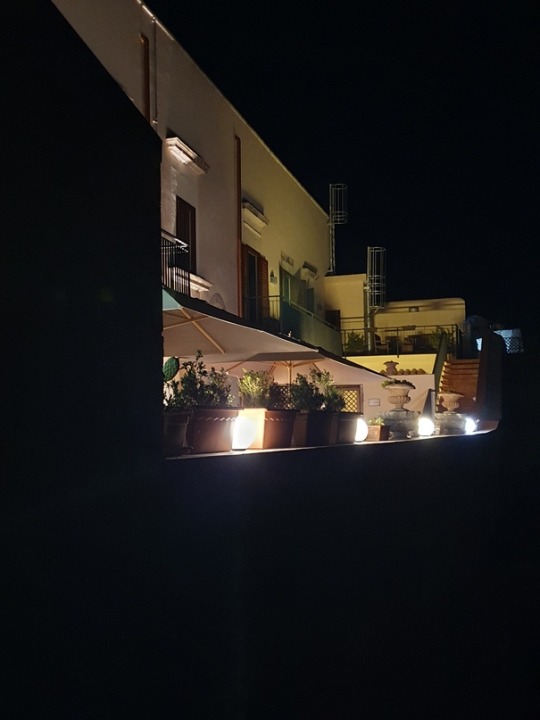
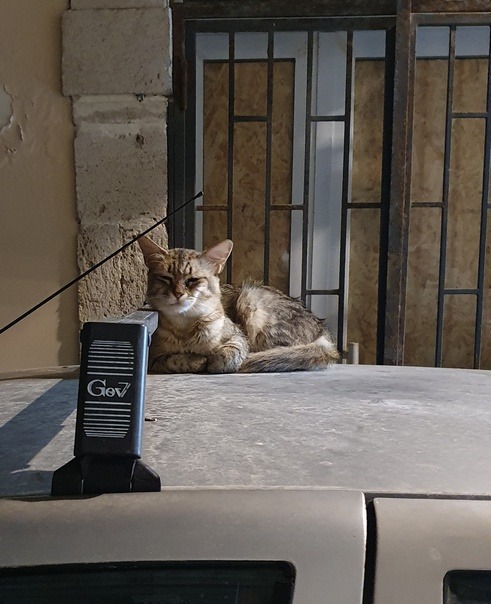
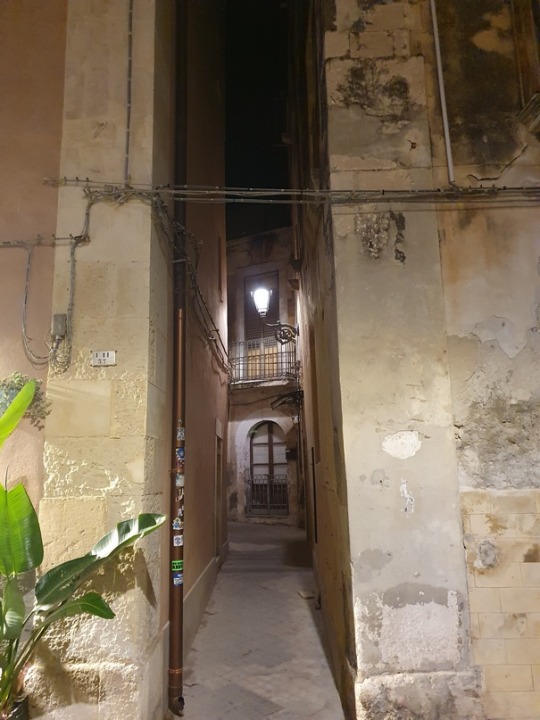


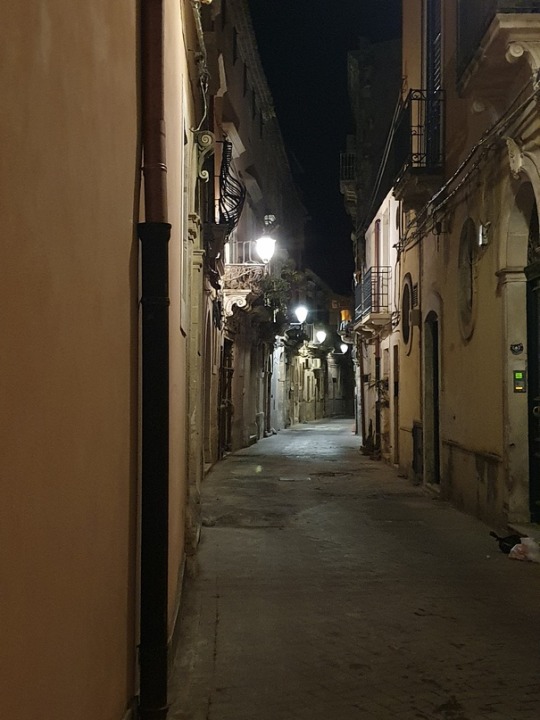
ORTIGIA DI NOTTE
Abbiamo pranzato in un vecchio ristorante di Ortigia. Fino a qualche anno fa vi erano i due fratelli che l’avevano ereditato dal padre. Eravamo in confidenza e quando ci sedevamo a tavola non ci portavano neanche il menù ma una serie di piatti con antipasti tipici di Siracusa. La pasta alla Meggellina o allo scoglio gli spaghetti al nero di Sicci, la frittura, l’arrosto, la stessa cassata con cui si finiva il pranzo, seguivano le stagioni, la disponibilità del momento. Ora il ristorante è uno dei tanti, con piatti belli a vedersi ma insapori, ed un menù che è lo stesso di Milano o Düsseldorf. Siracusa dalla tavola è scomparsa nella ricerca del Glamour, di una supposta eleganza che giustifica un costo non equilibrato con il pranzo servito. Per questo ci avventuriamo nella notte di Origia con la paura di non trovare più la sua anima accogliente ed antica. Ci accolgono i grandi Yacht dalle forme eleganti che sanno di una ricchezza che cerca ancora l’avventura tra le vele di due alberi o nei ponti eleganti di una cattedrale marina. Poi però torna Ortigia, i suoi enormi baobab la fontana di Aretusa, torna nelle feste sulle barche luminose ormeggiate ai lati delle grandi mura o in quella nei balconi luminosi delle antiche case. Ortigia vive il suo mare e vive sé stessa, di giorno e di notte, indifferente ai tanti turisti per cui l’hanno camuffata e popolata di ristoranti, vive nel silenzio che avvolge i suoi balconi, nella luce giallognola dei suoi vicoli, nelle feste dei ragazzi nelle sue oscure spiaggette, nel vento che l’attraversa e nel tempo che non la vince. Nel silenzio della notte e nei pub stracolmi, tra tavolini e barche in cui rimbomba la musica da discoteca, come un’antica signora che l’oblio non potrà mai vincere, Ortigia vive.
We had lunch in an old restaurant in Ortigia. Until a few years ago there were two brothers who had inherited it from their father. We were friend and when we sat down at the table they didn't even bring us the menu but a series of dishes with typical Syracuse appetizers. The Meggellina or scoglio pasta, black Sicci's spaghetti (cutttlefish spaghetti) with black sauce, the fried food, the roast, the same cassata with which we finished lunch, followed the seasons, the availability of the moment. Now the restaurant is one of many, with dishes that are beautiful to look at but tasteless, and a menu that is the same as in Milan or Düsseldorf. Syracuse has disappeared from the table in the search for Glamour, for a supposed elegance that justifies a cost that is not balanced with the lunch served. This is why we venture into the night of Origia with the fear of no longer finding its welcoming and ancient soul. We are welcomed by large yachts with elegant shapes that smell of a richness that still seeks adventure between the sails of two masted ship or in the elegant descks of a marine cathedral. But then Ortigia returns, its enormous baobabs, the fountain of Arethusa, returns to the celebrations on the bright boats moored at the sides of the great walls or in the bright balconies of the ancient houses. Ortigia lives its sea and lives itself, day and night, indifferent to the many tourists for whom they have disguised it and populated it with restaurants, it lives in the silence that envelops its balconies, in the yellowish light of its alleys, in the festivals of teeneger in its dark little beaches, in the wind that crosses it and in the time that does not overcome it. In the silence of the night and in busy pubs, between tables and boats in which disco music booms, like an ancient lady that oblivion can never conquer, Ortigia lives.
27 notes
·
View notes
Text
Birthdays 12.14
Beer Birthdays
John Frederick Wiessner (1831)
Simon Fishel (1846)
Vic Kralj (1959)
Five Favorite Birthdays
Tycho Brahe; Danish astronomer (1546)
Shirley Jackson; writer (1919)
Ginger Lynn; adult actress (1962
Stan Smith; tennis player (1946)
Clark Terry; jazz trumpet player (1920)
Famous Birthdays
Morey Amsterdam; comedian, actor (1908)
Kelley Armstrong; Canadian author (1968)
DeFord Bailey; country and blues musician (1899)
Margaret Bakkes; South African author (1930)
Lester Bangs; music journalist & author (1948)
Aphra Behn; English playwright and author (1640)
Ewa Białołęcka; Polish author (1967)
Jane Birkin; English singer, actor (1946)
Capel Bond; English organist & composer (1734)
Boudewijn Büch; Dutch author, poet & tv host (1948)
T. K. Carter; actor (1956)
David A. Cherry; artist & illustrator (1949)
Anne Conway; English philosopher and author (1631)
Jane Cowl; actress and playwright (1884)
Dan Dailey; singer, dancer, actor (1913)
Ernie Davis; Syracuse RB (1939)
James Doolittle; aviator (1896)
Patty Duke; actress (1946)
Paul Éluard; French poet and author (1895)
Herbert Feigl; Austrian philosopher (1902)
Roger Fry; English painter (1866)
George Furth; actor & playwright (1932)
Cynthia Gibb; actress (1963)
Miranda Hart; English actress (1972)
Scott Hatteberg; Oakland A's 1B/C (1969)
Don Hewitt; journalist & 60 Minutes creator (1922)
Vanessa Anne Hudgens; actress (1988)
Spike Jones; bandleader, comedian (1911)
Jan Antonín Koželuh; Czech composer (1738)
Abbe Lane; singer, actress (1932)
John Lurie; actor, saxophonist, painter & director (1952)
Krissy Lynn; adult actress (1984)
Steve MacLean; Canadian physicist & astronaut (1954)
Natasha McElhone; English-Irish actress (1971)
Sophie Monk; English-Australian singer-songwriter & actress (1979)
Alexander Nelke; Estonian-American painter (1894)
Nostradamus; French astrologer, physician (1503)
Beth Orton; English singer-songwriter & guitarist (1970)
Michael Ovtiz; talent agent (1946)
Jill Pipher; mathematician (1955)
Lee Remick; actress (1935)
Gerard Reve; Dutch-Belgian author & poet (1923)
Charlie Rich; country singer (1932)
Kyle Shanahan; football coach (1979)
Xul Solar; Argentinian painter and sculptor (1887)
Jon Staggers; Green Bay Packers WR (1948)
KaDee Strickland; actress (1975)
June Taylor; dancer & choreographer (1917)
Hans von Ohain; German-American physicist & engineer (1911)
Michaela Watkins; actor & comedian (1971)
Joyce Vincent Wilson; singer (1946)
Charles Wolfe; Irish poet (1791)
Mary Tappan Wright; novelist and writer (1851)
Tata Young; Thai singer, model, actor (1980)
2 notes
·
View notes
Text
The Legend of the Seven Seas | Masterlist





Started: 29.12.2024 Finished: Last Update: 29.12.2024

Summary: The Book of Peace - an ancient book which protects the twelve cities. Stored in the highest tower in the city of Syracuse, the book stands untouched as Prince Sabo brought it home. The prosperity it brings to humanity made it a target to the Goddess of discord Eris, who intends to bring chaos to the people of the twelve cities by making a deal with the famous pirate Portgas D Ace to steal it.
“You're not thinking big enough, Ace. Steal the book for ransom and you can be rich enough to lounge on the beach of a tropical island. Steal it for me, and you can buy the beach. And the island. And the world.” Said Eris, her voice sultry as she passed by Ace, fingers brushing his face.
Main characters: Portgas D Ace x Reader (female) & Eris - Goddess of Discord
Supporting characters: Luffy, Sabo, Marco, Thatch, Izo, Kiku, Whitebeard
Description: This story is entirely based on 'Sinbad: The Legend of the Seven Seas'! Of course I will add my own touch to it and things that are not part of the film, but still it will be following the animation storyline. A lot of lines that I liked from the movie will be included in the dialogue as well.
WARNINGS: explicit language, descriptions of violence, 18+ only, contains explicit sexual themes and content, use of alcohol, implied injury, slow burn, illegal activities, conflicted feelings, conflicted relationship, emotional distress, jealousy, suggestive themes, violence, mentions of monsters. (+ every chapter has it own warnings)



Chapter I | A word of a Goddess
Chapter II | coming soon…

writing, format, header & dividers © eand47 ©eand47, do not copy or plagiarise my work.
#portgas d ace#one piece#one piece ace#fire fist ace#portgas d ace x reader#portgas ace x reader#portgas ace x you#one piece x y/n#one piece x you#one piece x reader#one piece sabo#monkey d. luffy#portgas d ace x y/n#portgas d ace x you#portgas ace x y/n#ace x y/n#ace x you#ace x reader#ace one piece#whitebeard pirates#whitebeard one piece#whitebeard crew#marco the phoenix#thatch one piece#one piece luffy#straw hat luffy#mugiwara no luffy#izo one piece#asl brothers#asl trio
90 notes
·
View notes
Text
On my way home from a party tonight i drove through a rich people neighborhood and I just need to know who, besides the basketball and football coaches, in Syracuse can afford million+ dollar homes. There’s jobs here it’s not a complete shithole but what do they do for work? Banking? Corporate Lawyer? This whole place is so fascinating to me
2 notes
·
View notes
Text
Dissolve
Rating: Gen
Word Count: 616
Pairing: Aether/Dew
Tags: Angst, hurt no comfort, major character death (or at least some super vague ideas about ghouls who are sent back to the pit), eventual hurt/comfort in part 2
A/N: Wrote a horrible, angsty little thing instead of cleaning house and preparing for trip to the East Coast for Syracuse ritual. Planning on this being part 1 of an Aether/Dew hurt/comfort thing, but as of this chapter it's all hurt, no comfort, so reader beware.
Read on Tumblr for now, will upload to Ao3 whenever part 2 happens:
Aether carried a torch for Dew until his final moments, until the dark ashen hands reached up from the summoning circle to drag him back into the pit. The last thing Aether sees as he’s pulled under, away from his life topside, away from his home and his pack, is Dew. Aether’s mind is screaming out for him in those final moments. Begging. Please. Look at me. Reach out to me, give me a sign, anything. Anything to know that you might have felt even a fraction of the love I felt for you. What he sees instead is Dew with a pained face, staring at the ground in front of him, leaning closer into Swiss’ side.
Even now, as Aether floats in the dark, cool void of the pit, he feels his memories fading, pulled out of his consciousness to dissolve into the nothingness as he becomes one with the quintessence surrounding him. He sees his most precious memories unspool backwards and unravel far, far away from him. Dissipating into nothing like smoke into the air.
They’re all of Dew.
He sees Dew asleep on the bus from their last tour, head tipped back in his seat and expression soft as he sleeps. Aether wanted to kiss him awake so badly then. He didn’t know it, but that night was the last time they’d ever play guitar together. He sees it all in vivid detail, down to the loose threads of the seat cushions and the rich green of the trees passing by out the window.
And then that memory is no more.
Aether sees before that. It’s summer at the abbey, and all the ghouls are together at the lake. He’s got Dew on his shoulders as they play a game of chicken against Swiss and Rain. They’ve lost every match, but with Dew’s high pitched giggling and his skinny little thighs flexing beneath Aether’s strong hands, Aether thinks, This is where I belong. Holding you up and bathed in your joy, blessed by the holy sound of your laughter.
And then another memory, gone and dissolved into the darkness of space.
Aether sees farther back, to the moment Dew transitioned from water to fire. He remembers Dew in the infirmary, unconscious and sweating, fighting through his body’s changes, delicate skin angry and charred from where the flames burned away his gills and fins. Aether had been so scared then, but Dew was strong. Stronger than anyone Aether had ever known. He’d come so close to telling Dew he loved him then. But when Dew cracked his tired eyes open, all Aether could manage to do was pull him into a tight hug as he choked back tears and hoped Dew felt what he was trying so desperately to say.
And then Aether remembers nothing of it.
Finally, he sees Dew on the day they first met. The day that Dew was summoned by the clergy. Aether sees himself watching the most beautiful ghoul he’d ever seen in his life emerge from the glowing circle of the pit. Delicate and slender with hair so long and platinum it almost shone sliver in the dim light of the abbey. Aether sees himself slack-jawed, hands shaking as he moves to wrap a blanket around the new ghoul. He remembers feeling all the air sucked out of the room as Dew looked up at him for the very first time, with wild, flashing eyes and Aether thinks to himself I can’t wait to devote the rest of my life to the worship of you.
And then, as this last most precious thought is swept away from him, Aether feels himself fade finally into the peace of nothingness.
#aether ghoul#dewdrop ghoul#aether/dew#aether/dewdrop#dewther#ghost band fanfic#forever plagued by angsty aeth/dew thoughts#hoping to finish part 2 before i fly out but who knows!#ghoul-slime fic
21 notes
·
View notes
Note
i went to a cheap ass state school close to syracuse and i think u dodged a bullet syracuse students are the worst ever. i had to visit the art gallery sometimes and every time the campus was littered with rich 19 yos full throat shrill screaming at their rich parents via iphone. only good thing is the shiny black squirrels.
I wish I could tell you I did dodge that bullet but the place where I actually ended up going is not just one bullet but instead a machine gun and I’m actively running into its line of fire like willem dafoe in platoon
21 notes
·
View notes